

Understanding the equation will simplify the concept of dead space greatly. The Bohr equation can be used to calculate the amount of dead space in a lung. One can see an increase in the value of physiologic dead space in lung disease states where the diffusion membrane of alveoli does not function properly or when there are ventilation/perfusion mismatch defects. Therefore, physiologic dead space is equivalent to anatomical. In a healthy adult, alveolar dead space can be considered negligible. The respiratory zone is comprised of respiratory bronchioles, alveolar duct, alveolar sac, and alveoli.
NORMAL TIDAL VOLUME PLUS
Physiologic or total dead space is equal to anatomic plus alveolar dead space which is the volume of air in the respiratory zone that does not take part in gas exchange. This volume is considered to be 30% of normal tidal volume (500 mL) therefore, the value of anatomic dead space is 150 mL. Anatomical dead space is represented by the volume of air that fills the conducting zone of respiration made up by the nose, trachea, and bronchi. The two types of dead space are anatomical dead space and physiologic dead space. Ann Emerg Med.Dead space represents the volume of ventilated air that does not participate in gas exchange. Managing Initial Mechanical Ventilation in the Emergency Department. Management of mechanical ventilation in acute severe asthma: practical aspects. Effect of prolongation of expiratory time on dynamic hyperinflation in mechanically ventilated patients with severe asthma.

Do the NIH ARDS Clinical Trials Network PEEP/FIO2 tables provide the best evidence-based guide to balancing PEEP and FIO2 settings in adults?" Respiratory Care. "Respiratory controversies in the critical care setting.

"Ventilation With Lower Tidal Volumes As Compared With Traditional Tidal Volumes For Acute Lung Injury And The Acute Respiratory Distress Syndrome". Absorption Atelectasis: Incidence and Clinical Implications. The Acute Respiratory Distress Syndrome Network. Ventilation with lower tidal volumes as compared with traditional tidal volumes for acute lung injury and the acute respiratory distress syndrome. ↑ The Acute Respiratory Distress Syndrome Network.Recommendations for mechanical ventilation of critically ill children from the Paediatric Mechanical Ventilation Consensus Conference (PEMVECC). Normal ranges of heart rate and respiratory rate in children from birth to 18 years of age: a systematic review of observational studies. Cochrane Database Syst Rev 2010 11:CD003666. Volume-targeted versus pressure-limited ventilation in the neonate. ↑ Wheeler K, Klingenberg C, McCallion N, Morley CJ, Davis PG.EMdocs Pediatric Mechanical Ventilation.Adjusting mechanical ventilation settings.Initial mechanical ventilation settings.Initial mechanical ventilation settings (peds).Inspiratory flow rate = 60L/min (100 L/min with asthma).Consider reducing PEEP to maintain adequate preload and prevent/minimize hypotension.Maintain plateau pressure 30 go down on rate.Rate: See normal respiratory rates by age above.Normal Pediatric Respiratory Rates by Age AgeĪs a general rule, a traditional strategy is appropriate for most patients (similar to adults) Must use cuffed tube for volume-targeted ventilation.In the neonate, volume-targeted ventilation mode has been shown to have improved outcomes over pressure-limited ventilation.3.3 Lung Protective FiO2 and PEEP Scale.3.2 Lung Protective Mechanical Ventilation for Pediatric Patients.1.1 Normal Pediatric Respiratory Rates by Age.


 0 kommentar(er)
0 kommentar(er)
